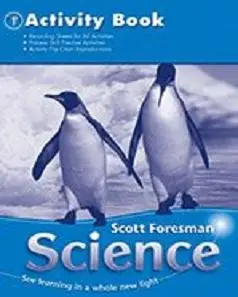Barbara Foots, "Scott Foresman Science: Grade 1 (Teacher edition)"
Scott Foresman & Co | 2006 | ISBN: 0328126225 | 506 pages | PDF | 106 MB
Scott Foresman & Co | 2006 | ISBN: 0328126225 | 506 pages | PDF | 106 MB
successfully teaching Scott Foresman Science are located in an easy-to-use guide. It includes easy-to-follow lesson plans; oversized mini-pages; additional activities; cross-curricular options; quick activities, and quick summaries for when time is limited. Lessons are organized into four units: Life Science, Earth Science, Physical Science, and Space and Technology. Each unit contains a balance between important science content and hands-on activities (through scaffolded inquiry) that support every lesson. You'll also find biographies, careers, and a NASA Connection in all units.
UNIT A: Life Science
Chapter 1: Living and Nonliving
- Lesson 1: What are living things?
- Lesson 2: What do plants need?
- Lesson 3: What do animals need?
- Lesson 4: What are nonliving things?
Chapter 2: Habitats
- Lesson 1: What is a forest habitat?
- Lesson 2: What is a wetland habitat?
- Lesson 3: What is an ocean habitat?
- Lesson 4: What is a desert habitat?
Chapter 3 How Plants and Animals Live
- Lesson 1: What helps animals live in their habitats?
- Lesson 2: How do animals get food?
- Lesson 3: What can help protect animals?
- Lesson 4: What are some parts of plants?
- Lesson 5: What helps protect plants?
Chapter 4: Life Cycles
- Lesson 1: How does a frog grow?
- Lesson 2: How does a butterfly grow?
- Lesson 3: How do animals grow and change?
- Lesson 4: How does a daisy grow?
- Lesson 5: How do trees grow?
- Lesson 6: How do plants grow and change?
Chapter 5: Food Chains
- Lesson 1: How do plants and animals get food?
- Lesson 2: How do living things get food in a rain forest?
- Lesson 3: How do living things get food in a marsh?
UNIT B: Earth Science
Chapter 6: Land, Water, and Air
- Lesson 1: What makes up Earth?
- Lesson 2: What are rocks and soil?
- Lesson 3: What changes land?
- Lesson 4: How do living things use natural resources?
- Lesson 5: How can you reduce, reuse, and recycle?
Chapter 7: Weather
- Lesson 1: How can you measure weather?
- Lesson 2: How do clouds form?
- Lesson 3: What are some kinds of wet weather?
- Lesson 4: What are the four seasons?
UNIT C: Physical Science
Chapter 8: Observing Matter
- Lesson 1: What is matter?
- Lesson 2: What are solids, liquids, and gases?
- Lesson 3: How does matter change?
- Lesson 4: How can water change?
- Lesson 5: What are other ways matter changes?
Chapter 9: Movement and Sound
- Lesson 1: What makes things move?
- Lesson 2: What is speed?
- Lesson 3: How do things move?
- Lesson 4: What do magnets do?
- Lesson 5: How are sounds made?
- Lesson 6: What sounds are around us?
Chapter 10: Learning About Energy
- Lesson 1: What gives off heat?
- Lesson 2: What can energy do?
- Lesson 3: What makes light and shadows?
- Lesson 4: What uses energy around us?
- Lesson 5: How do you get energy?
UNIT D: Space and Technology
Chapter 11: Day and Night Sky
- Lesson 1: What is in the day sky?
- Lesson 2: What causes day and night?
- Lesson 3: What is in the night sky?
Chapter 12: Science in Our World
- Lesson 1: How do farmers use technology to grow food?
- Lesson 2: How does food get from the farm to the store?
- Lesson 3: What tools can you use to make dinner?
- Lesson 4: How do builders get wood for a house?
- Lesson 5: What are simple machines?
- Lesson 6: What can you use to communicate?
Not all books on AvaxHome appear on the homepage.
In order not to miss many of them follow ebooks section (see top of each page on AH)
and visit my blog too :)
In order not to miss many of them follow ebooks section (see top of each page on AH)
and visit my blog too :)
NO MIRRORS according to the rules



